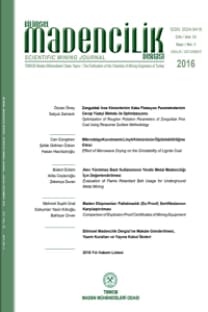TÜRK KÖMÜRLERİNİN KENDİLİĞİNDEN YANMAYA YATKINLIĞI - ILGIN LİNYİTLERİ ÖRNEĞİ
Kömürün kendiliğinden oksidasyonu temel anlamda kendiliğinden yanmadır. Kömür ve oksijenin mevcudiyetinde, ekzotermik bir reaksiyon oluşur ve açığa çıkan ısı uzaklaştınlamadığmda, kömür sıcaklığında bir artışa neden olur. Bu oksidasyon işlemi kömür kütlesi tutuşuncaya kadar devam edecektir. Bu olay, "kömürün kendiliğinden yanması" olarak literatürde yer bulmuştur. Bu makalede, Türk kömürlerinin kendiliğinden yanmaya yatkınlıkları konusunda daha önce yapılan çalışmaların sonuçlarına yer verilmiştir. Ayrıca, mevcut çalışmanın amacı olarak, kesişim noktası metodunun uygulanması ile Ilgın kömürlerinin kendiliğinden yanmaya yatkınlıkları araştırılmıştır
Anahtar Kelimeler:
Türk Kömürleri, Kömürün Kendiliğinden Yanması, Kesişim Noktası Metodu
Spontaneous Combustion Liability of Turkish Coals - Ilgın Lignites As Ân Example
Self-oxidation of coal mainly results in spontaneous combustion. In the presence of coal and oxygen, a reaction mostly occurs giving off heat that causes an increase in the coal temperature if not dissipated. So called oxidation process will go on until the mass of coal will ignite. This phenomenon is commonly known as spontaneous combustion. In this study, the results of the previous works carried out to search the liability of Turkish coals to spontaneous heating will be summarised. Additionally, as the objective of the present study, the coal samples from Ilgm District were investigated in terms of liability to spontaneous combustion by the utilisation of the crossing point temperature method
- ISSN: 2564-7024
- Yayın Aralığı: Yılda 4 Sayı
- Yayıncı: TMMOB Maden Mühendisleri Odası
Sayıdaki Diğer Makaleler
TÜRK KÖMÜRLERİNİN KENDİLİĞİNDEN YANMAYA YATKINLIĞI - ILGIN LİNYİTLERİ ÖRNEĞİ
TTK KARADON MÜESSESESİ OCAKLARINDA SOLUNABİLİR TOZLARIN KUVARS İÇERİKLERİNİN ARAŞTIRILMASI
Melahat GEBEDEK (KARALİ), Vedat DİDARİ, Alaaddin ÇAKIR
HİDROJEN PEROKSİT'İN REFRAKTER TİP GÜMÜŞ CEVHERLERİNİN SİYANÜR LİÇ VERİMİ ÜZERİNDEKİ ETKİSİ
M. S. Uğur BİLİCİ, Feridun AKYOL
FLOTASYONDA SU İLE TAŞINIM MODELLEME YAKLAŞIMLARININ DEĞERLENDİRİLMESİ
